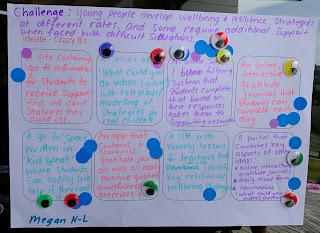Having been invited to be a Digital Associate Teacher, I was not 100% sure what to expect, given that it was going to be a completely online experience. However, I am so glad that I took up this opportunity as it made me look at my online learning site from a whole new perspective, and gave me an opportunity to talk through my site with people who were looking from the outside in.
Meeting my four student teachers was an interesting and fun experience. Using Google Meet, we were immediately faced with the usual tech difficulties - frozen screens, microphones not working, dropping connections...
However, with everyone able to problem solve, we were quickly able to get in to our meeting and introductions. After a few minutes, everyone was relaxed and I was so impressed with these four students and how they were tackling their studies in such a challenging situation. I can only imagine how hard it must be, in a one year teacher training programme to be unable to go out in to schools and interact with children face to face!
Touring my class site, discussing how my classroom works and sharing resources with them was an enjoyable experience. It did not actually feel like this was the first time meeting them, as they were so open to discussion and were able to ask a range of thought provoking questions. They were also able to see how things are in a normal classroom, as although we did not have any students present, there were certainly plenty of interruptions from other staff coming to ask questions about other matters, as well as my wonderful 8 year old who is very well equipped to interrupt online meetings!
We were able to unpack the range of abilities within my classroom, and how using online tools can support students at all levels to access their learning. We discussed the difference between using a class site as the front facing environment, while using Workspace allows me to group and collate student work, with a public view, and a private view where only I can see student work. We also discussed the use of pen and paper versus digital, and how in trying to meet all needs in the classroom, we use a range of both! We also discussed the Manaiakalani pedagogy of 'Learn, Create' Share' and why this is so important in a classroom setting. I will look forward to hopefully seeing my student teachers commenting on some of my student's blogs in the coming week.
Operating on the idea that giving students choice around their learning is more often successful than only giving them one option, I have posed a few different briefs for my students, all of which relate to the area of Literacy.
- I have a group of learners who are still at the decoding stage of reading. They are needing to sound out or break words down in to letter/sound patterns in order to read the words in the story.
- I have a group of students who struggle with inference when reading a text/story. While they are able to quickly find answers to ‘within the text questions’ (as long as questions are in the same order as the text), they struggle to answer “why do you think..” type questions, that encourage them to think beyond the text.
- I have a group of students who need to expand their understanding of vocabulary in order to access and understand higher level texts. For example, when faced with unknown words outside of the essential lists, many do not have the vocabulary knowledge to unpack new words and understand what they are reading. When faced with new or unknown words, they do not use known reading strategies such as reading on to try and make meaning.
- I have a group of students who are still not using basic punctuation such as capital letters and fullstops consistently within their writing. As a result, their sentences run together and they lose meaning.
- I have a group of students who love to try and use dialogue within their creative writing. However, they are not able to consistently use punctuation such as speech marks and supporting punctuation (Question marks, exclamation marks) to show different speakers within the story.
I am very much looking forward to meeting up with my students again, and seeing what digital tools they have created, based on one of the above briefs. I have also said that I am happy to use their designs in Week 12, so that they can get some actual student feedback on their work, or see what students are able to create, based on their site.








